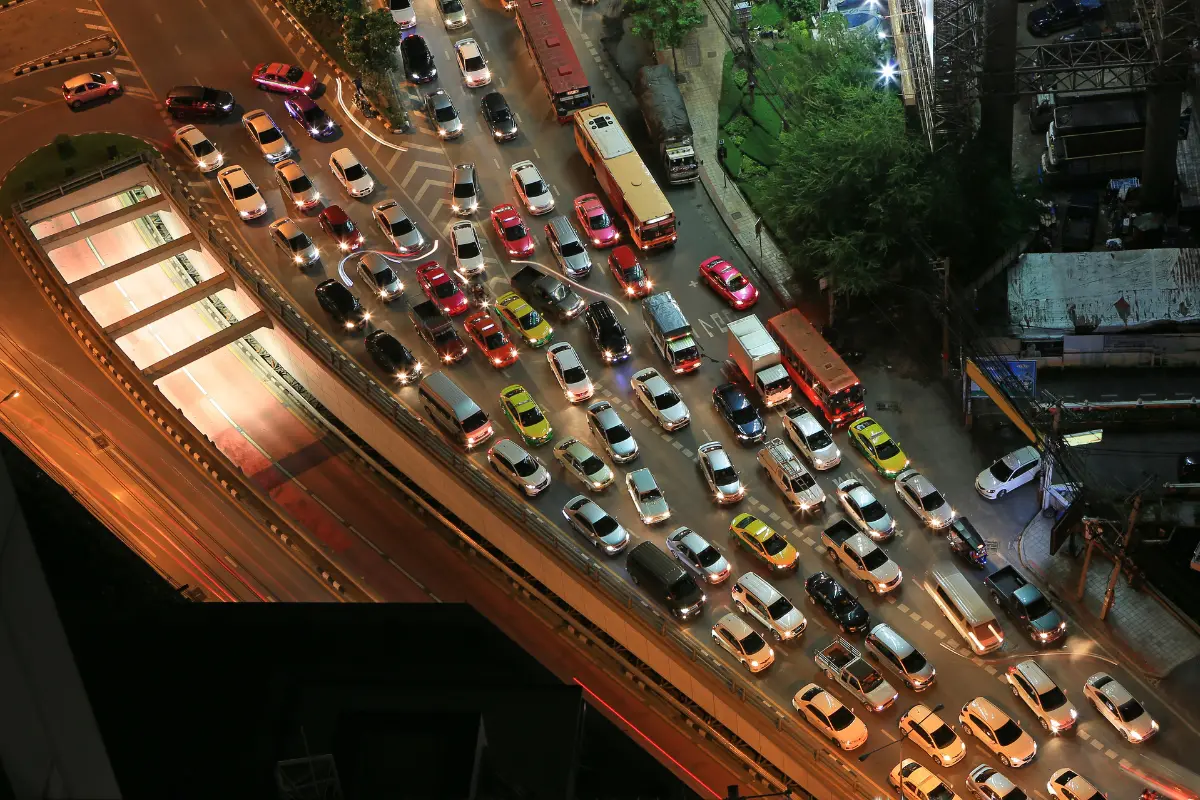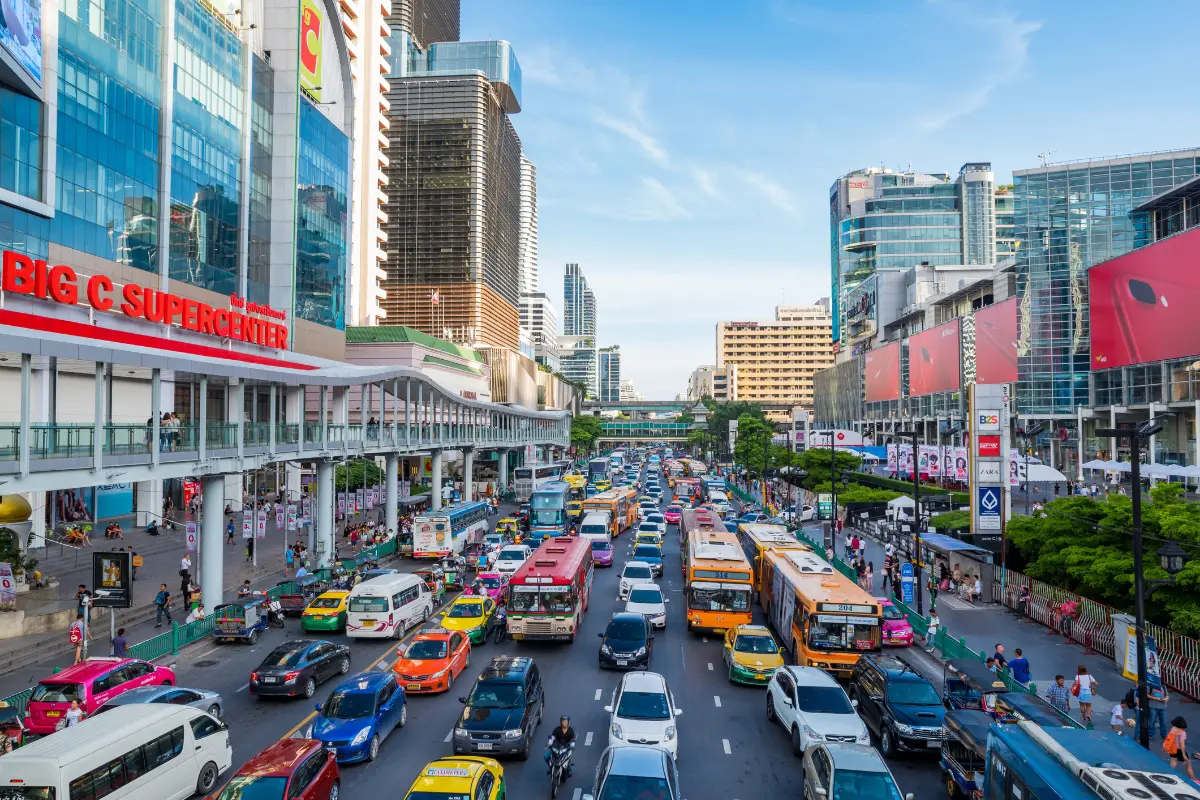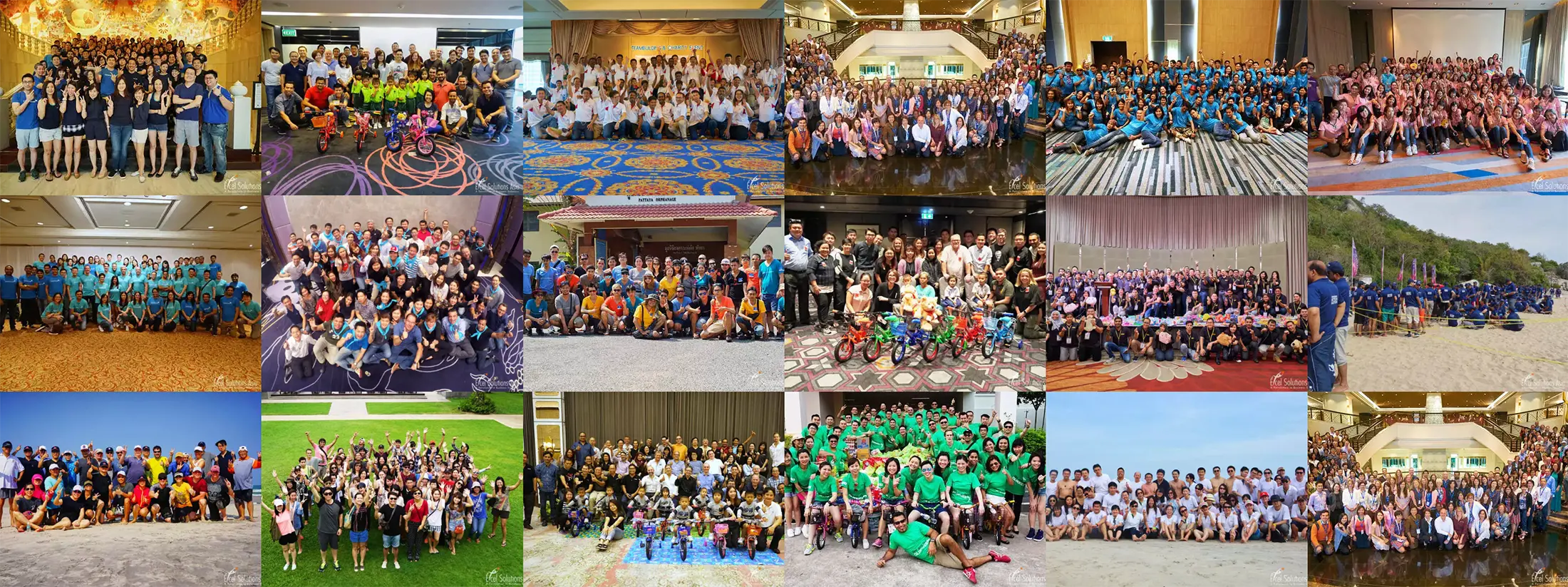Bangkok is one of the world’s most congested cities, with severe traffic problems that can make it challenging to get around the city during the peak rush hour. Here are some reasons why Bangkok traffic is so bad in rush hour:
Lack of Roads
Bangkok’s main roads are not large enough to accommodate the amount of traffic during rush hour, and they were also squeezed in by commercial real estate projects, leaving little space for expansion.
Private Automobile Use
Almost two-thirds of trips in Bangkok are made using private vehicles, which further clog the city’s limited road space.
Lack of Public Transport
Bangkok’s public transportation system is not extensive enough to meet the needs of the city’s population during rush hour, leading to more people relying on private vehicles.
Traffic Management
Traffic management in Bangkok is poor, with a lack of effective traffic control measures and enforcement of traffic laws.
Environmental Issues
Traffic congestion worsens air quality, and Bangkok’s air quality has degenerated to levels deemed unsafe.
To reduce traffic congestion during rush hour, Bangkok needs to address these issues. The city has made efforts to improve public transportation, such as adding mass transit systems, but more needs to be done!
Bangkok Traffic Statistics 2023
According to the search results, here are some traffic statistics for Bangkok in 2023:
- The average traffic volume per day on Bangkok’s expressways and metro is expected to be around 1,100 thousand trips.
- The traffic congestion index in Bangkok was reported at 40.470 in August 2023, which is an increase from the previous number.
- Travel time increased in Bangkok last year, and the average time it took to travel 10 km increased by 2 min 40s.
- Bangkok ranks 25th in the Traffic Index by City 2023 Mid-Year, with a traffic index of 212.6.
- As of May 2023, there were approximately 34.5 thousand road accidents in Bangkok.
- Traffic congestion in Bangkok wastes about 97 million baht worth of fuel each day. This not only affects the environment but also increases the cost of commuting.
- Bangkok has a limited road surface area, which is only eight percent compared to 20-30 percent in most Western cities. This limited capacity means that the existing road system can accommodate only 1.5 million vehicles, while there are about nine million registered vehicles in Bangkok and surrounding provinces.
- Traffic congestion in Bangkok contributes to air pollution, which can cause respiratory problems and other health issue.
These statistics suggest that traffic congestion is a significant issue in Bangkok, and visitors should plan accordingly when traveling around the city. Using public transportation, such as the BTS and MRT, can help avoid traffic and save time. Visitors should also be aware of the potential risks of road accidents and take precautions when traveling by car or motorcycle.
Bangkok Traffic Statistics Source
- Traffic Index Traffic Congestion in Bangkok
- Ceicdata Traffic Congestion Index: Average: Thailand: Bangkok
- TomTom Bangkok Traffic
Bangkok Rush Hour and Possible Solutions

Rush hour in Bangkok can be a challenging experience due to the heavy traffic congestion in the city. This is one of the reasons we recommend finishing our team building activities in Bangkok before 5.00! Here are some tips and information to help navigate rush hour in Bangkok:
Plan Ahead
Always allow plenty of time for travel in rush hour, especially during the morning peak (07.30 – 09.30) or evening rush hours (16.30 – 18.30). It’s also important to check the weather forecast as heavy rain can cause traffic to back up.
Use Alternate Transportation
Consider using alternate transportation such as the BTS Skytrain, MRT subway, or boats along the Chao Phraya River. These options can be faster and more efficient than traveling by car or taxi. However, even the BTS and MRT can be congested during rush hour!
Avoid Peak Hours
If possible, try to avoid traveling during peak hours. Rush hour in Bangkok is round the clock, but there may be some relief on trains between 10.30 am and 3.30 pm.
Be Patient
Traffic in Bangkok can be slow-moving, so it’s important to be patient and allow extra time for travel. It’s also important to stay calm and avoid aggressive driving.
Know the Worst Locations for Traffic Jams
There are numerous local hotspots throughout the city where traffic tends to build up quickly, such as Sukhumvit Road, Silom, and Ratchaprasong Intersection (Siam Square). Knowing these locations can help you plan your route accordingly.
What are the long-term solutions?
Long-term rush hour solutions proposed to address traffic congestion include:
- Expansion of mass transit systems: There is a need for a major mass transit system capable of carrying a large number of people. Efforts have been made to expand the existing mass transit systems, such as the BTS Skytrain and MRT subway, to provide more coverage and capacity.
- Improvement of public transportation: Enhancing the efficiency and accessibility of public transportation is crucial to reduce reliance on private vehicles. This includes increasing the frequency and capacity of buses, improving bus routes, and integrating different modes of public transport.
- Congestion charging: Implementing congestion charging systems, similar to those in cities like London and Singapore, has been proposed as a way to manage traffic volumes. Congestion charges would discourage private vehicle use during peak hours and generate revenue for transportation infrastructure improvements.
- Promotion of alternative modes of transportation: Encouraging walking, cycling, and the use of electric scooters in rush hour can help reduce traffic congestion. Developing infrastructure and implementing policies that prioritize these modes of transportation can provide viable alternatives to private vehicles.
- Urban planning and road infrastructure: Long-term solutions also involve better urban planning and the development of road infrastructure. This includes constructing new roads, improving existing road networks, and implementing intelligent transportation systems to optimise rush hour traffic flow.
- Promotion of carpooling and ride-sharing: Encouraging carpooling and ride-sharing initiatives can help reduce the number of vehicles on the road. This can be incentivized through policies, such as dedicated carpool lanes and reduced toll fees for carpool vehicles.
It is important to note that implementing these long-term solutions requires comprehensive planning, coordination between different stakeholders, and sustained investment in transportation infrastructure.
The Busiest Roads During Bangkok Rush Hour?
Here are some of the busiest roads in Bangkok:
- Vibhavadi Rangsit Road: According to City Hall’s Traffic, this is the busiest road in Bangkok, used by more than 150,000 vehicles each day.
- Khaosan Road: This is one of the busiest streets in Bangkok, known for its vibrant nightlife and street food.
- Sukhumvit Soi 38: This is a popular street in Bangkok known for its street food stalls and restaurants.
- Thonglor & Ekkamai: These two streets are known for their trendy bars, restaurants, and cafes.
- Royal City Avenue (RCA): This is a popular nightlife area in Bangkok, with many clubs and bars.
- Maha Rat Road: This road runs parallel with the Chao Phraya River and is where many of Bangkok’s major temples and attractions are located.
- Rama I Road: This road is home to many shopping centers and malls, making it a popular destination for shoppers.
These are just a few of the busiest roads during rush hour in Bangkok, and there are many more that experience heavy traffic congestion.
The busiest intersections during Bangkok Rush Hour
Here are some of the busiest intersections during Bangkok’s rush hour:
- Asoke Junction: This is considered the busiest intersection in Bangkok, with over 500,000 people passing through it each day.
- Victory Monument: This is a major transportation hub in Bangkok, with buses, vans, and taxis converging at this intersection.
- Ratchaprasong Intersection: This intersection is located in the heart of Bangkok’s shopping district and is known for its high-end shopping malls.
- Silom Intersection: This is a major intersection in Bangkok’s financial district, with many office buildings and banks located nearby.
- Siam Intersection: This intersection is located in the heart of Bangkok’s commercial district and is known for its large shopping malls and entertainment venues.
- Rama IV Intersection: This intersection is located near many universities and is known for its bustling street food scene.
These are just a few of the busiest intersections in Bangkok, and there are many more that experience heavy traffic congestion.
Why is Bangkok Traffic So Bad in Rush Hour Conclusion?
In conclusion, traffic during Bangkok rush hour is a complex issue resulting from a combination of factors. The city’s rapid urbanization and population growth, limited infrastructure expansion, dependency on private vehicles, and challenges in Bangkok public transportation have all contributed to the notorious traffic congestion. Additionally, cultural driving behaviours, seasonal influences, and major events further compound the problem. However, this is still an awesome city for team building in Bangkok!
As visitors and residents navigate the bustling streets of Bangkok, it is essential to be patient, plan travel wisely, and consider using public transportation when possible during rush hour. By understanding the root causes of traffic congestion, hour by hour, individuals can play a role in contributing to a smoother and more efficient urban experience in this vibrant city.



